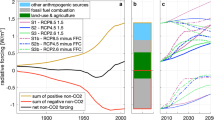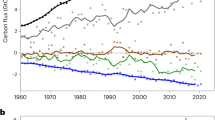Abstract
Using a coupled climate–carbon cycle model, fossil fuel carbon dioxide (CO2) emissions are derived through a reverse approach of prescribing atmospheric CO2 concentrations according to observations and future projections, respectively. In the second half of the twentieth century, the implied fossil fuel emissions, and also the carbon uptake by land and ocean, are within the range of observational estimates. Larger discrepancies exist in the earlier period (1860–1960), with small fossil fuel emissions and uncertain emissions from anthropogenic land cover change. In the IPCC SRES A1B scenario, the simulated fossil fuel emissions more than double until 2050 (17 GtC/year) and then decrease to 12 GtC/year by 2100. In addition to A1B, an aggressive mitigation scenario was employed, developed within the European ENSEMBLES project, that peaks at 530 ppm CO2(equiv) around 2050 and then decreases to approach 450 ppm during the twenty-second century. Consistent with the prescribed pathway of atmospheric CO2 in E1, the implied fossil fuel emissions increase from currently 8 GtC/year to about 10 by 2015 and decrease thereafter. In the 2050s (2090s) the emissions decrease to 3.4 (0.5) GtC/year, respectively. As in previous studies, our model simulates a positive climate–carbon cycle feedback which tends to reduce the implied emissions by roughly 1 GtC/year per degree global warming. Further, our results suggest that the 450 ppm stabilization scenario may not be sufficient to fulfill the European Union climate policy goal of limiting the global temperature increase to a maximum of 2°C compared to pre-industrial levels.
Similar content being viewed by others
References
Allen M, Ingram W (2002) Constraints on future changes in climate and the hydrological cycle. Nature 419:224–232
Boucher O, Pham M (2002) History of sulfate aerosol radiative forcings. Geophys Res Lett 29:1308. doi:10.1029/2001GL014048
Brasseur GP, Roeckner E (2005) Impact of improved air quality on the future evolution of climate. Geophys Res Lett 32:L23704. doi:10.1029/2005GL023902
Brohan P, Kennedy JJ, Harris I, Tett SFB, Jones PD (2006) Uncertainty estimates in regional and global observed temperature changes: a new dataset from 1850. J Geophys Res 111:D12106. doi:10.1029/2005JD006548
Canadell JG, Le Quéré C, Raupach MR, Field CB, Buitehuis ET, Ciais P, Conway TJ, Houghton RA, Marland G (2007) Contributions to accelerating atmospheric CO2 growth from economic activity, carbon intensity, and efficiency of natural sinks. Proc Natl Acad Sci U S A 104:18866–18870
Collatz GJ, Ribas-Carbo M, Berry JA (1992) Coupled photosynthesis-stomatal conductance model for leaves of C4 plants. Aust J Plant Physiol 19:519–538
Council of the European Union (2004) 2632nd Council meeting press release: environment, council of the European union, Brussels (available at http://europa.eu/rapid/pressReleasesAction.do?reference=PRES/04/357&format=HTML&aged=1&language=EN&guiLanguage=en)
Crueger T, Roeckner E, Raddatz T, Schnur R, Wetzel P (2007) Ocean dynamics determine the response of oceanic CO2 uptake to climate change. Clim Dyn 31:151–168
Etheridge DM, Steele LP, Langenfelds RL, Francey RJ, Barnola JM, Morgan VI (1996) Natural and anthropogenic changes in atmospheric CO2 over the last 1000 years from air in Antarctic ice and firn. J Geophys Res 101:4115–4128
Farquhar GD, von Caemmerer S, Berry JA (1980) A biogeochemical model of photosynthesis in leaves of C3 species. Planta 149:78–90
Feichter J, Roeckner E, Lohmann U, Liepert B (2004) Nonlinear aspects of the climate response to greenhouse gas and aerosol forcing. J Climate 17:2384–2398
Friedlingstein P (2008) A steep road to climate stabilization. Nature 451:297–298
Friedlingstein P, Cox P, Betts R, Bopp L, von Bloh W, Brovkin V, Cadule P, Doney S, Eby M, Fung I, Bala G, John J, Jones C, Joos F, Kato T, Kawamiya M, Knorr W, Lindsay K, Matthews HD, Raddatz T, Rayner P, Reick C, Roeckner E, Schnitzler K-G, Schnur R, Strassmann K, Weaver AJ, Yoshikawa C, Zeng N (2006) Climate–carbon cycle feedback analysis: results from the C4MIP model intercomparison. J Climate 19:3337–3353
Hansen J, Sato M, Kharecha P, Russell G, Lea DW, Siddall M (2007) Climate change and trace gases. Philos Trans R Soc (A) 365:1925–1954
Hewitt CD, Griggs DJ (2004) Ensembles-based predictions of climate changes and their impacts. Eos 85:566
Hibbard KA, Meehl GA, Cox PM, Friedlingstein P (2007) A strategy for climate change stabilization experiments. Eos 88:217–221
Houghton RA (2008) Carbon flux to the atmosphere from land-use changes 1850–2005. Carbon Dioxide Information Analysis Center (available at http://cdiac.ornl.gov/trends/landuse/houghton/houghton.html)
Jungclaus JH, Botzet M, Haak H, Keenlyside N, Luo JJ, Latif M, Marotzke J, Mikolajewicz U, Roeckner E (2006) Ocean circulation and tropical variability in the coupled model ECHAM5/MPI-OM. J Climate 19:3952–3972
Kloster S, Dentener F, Feichter J, Raes F, Lohmann U, Roeckner E, Fischer-Bruns I (2010) A GCM study of future climate response to aerosol reductions. Clim Dyn 34:1177–1194. doi:10.1007/s00382-009-0573-0
Knutti R, Joos F, Müller SA, Plattner G-K, Stocker TF (2005) Probabilistic climate change projections for CO2 stabilization profiles. Geophys Res Lett 32:L20707. doi:10.1029/2005GL023294
Lowe JA, Hewitt CD, van Vuuren DP, Johns TC, Stehfest E, Royer J-F, van der Linden PJ (2009) New study for climate modeling, analyses, and scenarios. Eos 90:181–182
Maier-Reimer E, Kriest I, Segschneider J, Wetzel P (2005) The Hamburg ocean carbon cycle model HAMOCC5.1—technical description release 1.1. Reports on earth system science 14 [available from Max Planck Institute for Meteorology, Bundesstr. 53, 20146 Hamburg, Germany, http://www.mpimet.mpg.de]
Marland G, Boden TA, Andres RJ (2003) Global, regional and national emissions. In trends: a compendium of data on global change. Carbon Dioxide Information Center, Oak Ridge National Laboratory, U. S. Department of Energy, Oak Ridge, Tenn., USA
Marsland SJ, Haak H, Jungclaus JH, Latif M, Röske F (2003) The Max Planck Institute global ocean/sea ice model with orthogonal curvilinear coordinates. Ocean Model 5:91–127
Matthews HD (2005) Decrease of emissions required to stabilize atmospheric CO2 due to positive carbon cycle–climate feedbacks. Geophys Res Lett 32:L21707. doi:10.1029/2005GL023435
Matthews HD, Caldeira K (2008) Stabilizing climate requires near-zero emissions. Geophys Res Lett 35:L04705. doi:10.1029/2007GL032388
May W (2008) Climatic changes associated with a global “2°C-stabilization” scenario simulated by the ECHAM5/MPI-OM coupled climate model. Clim Dyn 31:283–313
Pongratz J, Reick CH, Raddatz T, Claussen M (2008) A reconstruction of global agricultural areas and land cover for the last millennium. Glob Biogeochem Cycles 22:GB3018. doi:10.1029/2007GB003153
Pongratz J, Reick CH, Raddatz T, Claussen M (2009a) Effects of anthropogenic land cover change on the carbon cycle of the last millennium. Glob Biogeochem Cycles 23:GB4001
Pongratz J, Raddatz T, Reick CH, Esch M, Claussen M (2009b) Radiative forcing from anthropogenic land cover change since 800 AD. Geophys Res Lett 36:L02709. doi:10.1029/2008GL036394
Raddatz TJ, Reick CH, Knorr W, Kattge J, Roeckner E, Schnur R, Schnitzler K-G, Wetzel P, Jungclaus J (2007) Will the tropical land biosphere dominate the climate–carbon cycle feedback during the twenty-first century? Clim Dyn 29:565–574
Roeckner E, Brokopf R, Esch M, Giorgetta M, Hagemann S, Kornblueh L, Manzini E, Schlese U, Schulzweida U (2006) Sensitivity of simulated climate to horizontal and vertical resolution in the ECHAM5 atmosphere model. J Climate 19:3771–3791
Schellnhuber HJ, Cramer W, Nakicenovic NJ, Wigley T, Yohe G (eds) (2006) Avoiding dangerous climate change. Cambridge University Press, Cambridge, pp 392
Solomon S, 30 Co-authors (2007) Technical summary. In: Climate change 2007: the physical science basis. Contribution of working group i to the fourth assessment report of the intergovernmental panel on climate change. Technical report, Cambridge University Press, Cambridge, United Kingdom and New York, NY, USA
Søvde OA, Gauss M, Smyshlyaev SP, Isaksen ISA (2008) Evaluation of the chemical transport model Oslo CTM2 with focus on arctic winter ozone depletion. J Geophys Res 113:D09304. doi:10.1029/2007JD009240
United Nations (1992) United Nations Framework Convention on Climate Change (UNFCCC) (available at http://www.unfccc.int)
van Vuuren DP, den Elzen MGJ, Lucas PL, Eickhout B, Strengers BJ, van Ruijven B, Wonink S, van Houdt R (2007) Stabilizing greenhouse gas concentrations at low levels: an assessment of reduction strategies and costs. Clim Change 81:119–159
Washington WM, Knutti R, Meehl GA, Teng H, Tebaldi C, Lawrence D, Buja L, Strand WG (2009) How much climate change can be avoided by mitigation? Geophys Res Lett 36:L08703. doi:10.1029/2008GL037074
Weaver AJ, Zickfeld K, Montenegro A, Eby M (2007) Long term climate implications of 2050 emission reduction targets. Geophys Res Lett 34:L19703. doi:10.1029/2007GL031018
Wetzel P, Maier-Reimer E, Botzet M, Jungclaus J, Keenlyside N, Latif M (2006) Effects of ocean biology on the penetrative radiation in a coupled climate model. J Climate 19:3973–3987
Author information
Authors and Affiliations
Corresponding author
Rights and permissions
About this article
Cite this article
Roeckner, E., Giorgetta, M.A., Crueger, T. et al. Historical and future anthropogenic emission pathways derived from coupled climate–carbon cycle simulations. Climatic Change 105, 91–108 (2011). https://doi.org/10.1007/s10584-010-9886-6
Received:
Accepted:
Published:
Issue Date:
DOI: https://doi.org/10.1007/s10584-010-9886-6




